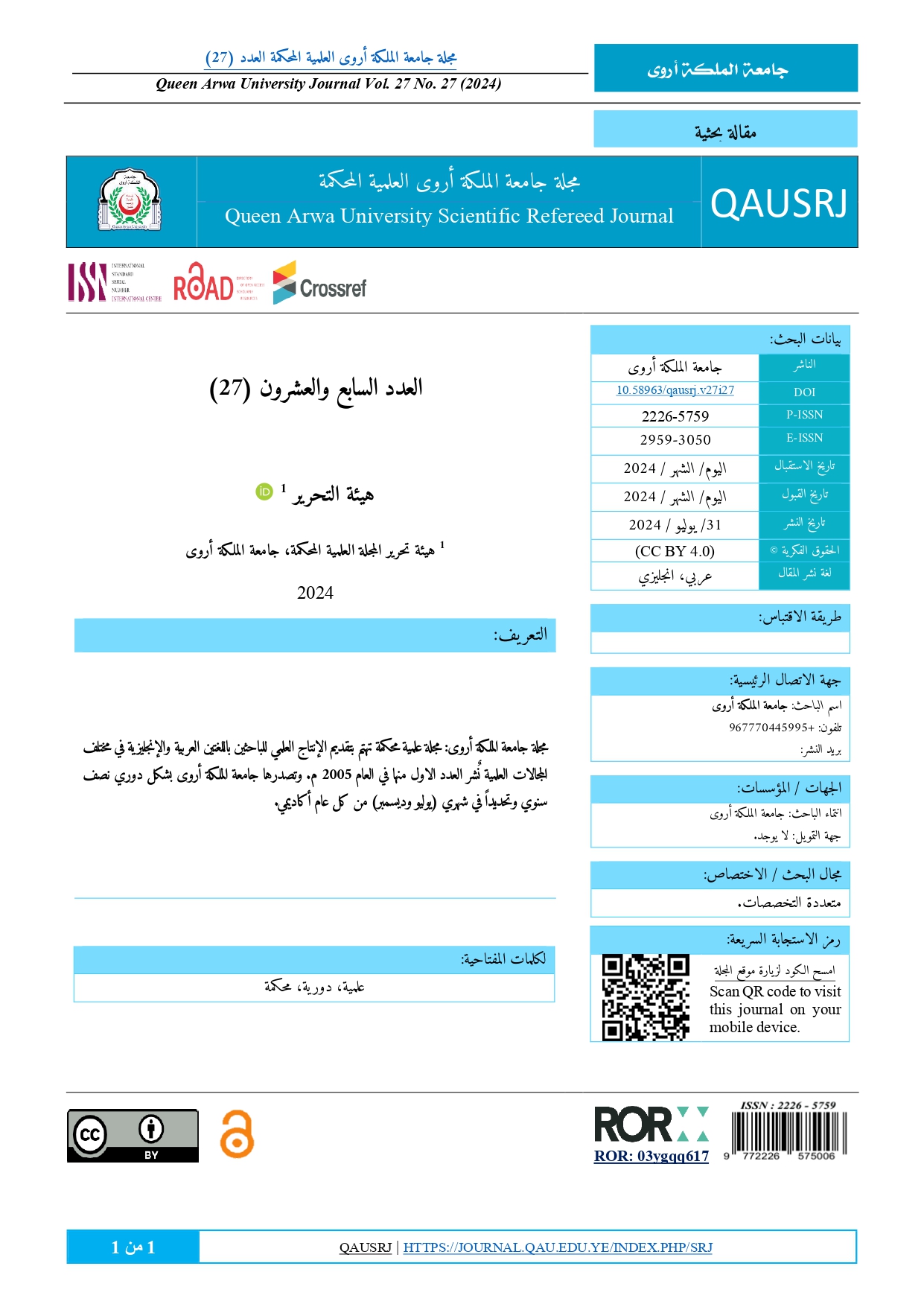Study the Antibiotics Use Without a Prescription and Their Misuse in Sana’a City
DOI:
https://doi.org/10.58963/qausrj.v27i27.295Keywords:
Antibiotics , Questionnaires , Multivariate AnalysisAbstract
This study aims to evaluate the knowledge and awareness of Sana'a city residents in Yemen about the correct use of antibiotics and their dangers. Additionally, it seeks to assess pharmacists' roles in the random dispensing of antibiotics and their knowledge of bacterial resistance. The study was conducted between June and August 2023 in Sana'a city, using a questionnaire for 261 adults who recently used antibiotics. The questionnaire included questions about participants' social status and both multiple-choice and open-ended questions. Results showed a very high level of antibiotic usage, with 68.6% using antibiotics more than five times in the past year. It was found that college-educated customers had the highest rate of antibiotic use. Most antibiotic users were aged 15-39 years. The main reasons for using antibiotics without a prescription were economic status followed by previous experiences. Public awareness was determined to be average regarding antibiotic use without a prescription. It is necessary to implement educational campaigns to increase awareness about antibiotic misuse and resistance.
Metrics
Downloads
References
Afolabi, M., Macarthy, L., & Osemene, K. (2014). Use of antimicrobial medicines among university students in Sierra Leone. British Journal of Pharmaceutical Research, 4(1), 101-112. https://doi.org/10.9734/BJPR/2014/5104
Aponte-González, J., Brown, P., & Eslava-Schmalbach, J. (2021). Preferences based interventions to address the use of antibiotics without prescription: A discrete choice experiment. Pharmacy Practice, 19(3), 2401. https://doi.org/10.18549/PharmPract.2021.3.2401
Askarian, M., Hosseingholizadeh, M., Danaei, M., & Momeni, M. (2013). A study of antibiotics self-medication at primary health care centers in Shiraz, Southern Iran. Health Science Surveillance System, 1(1), 1-5.
Belachew, S. A., Hall, L., & Selvey, L. A. (2020). Non-prescription dispensing of antibiotic agents among community drug retail outlets in Sub-Saharan African countries: A systematic review and meta-analysis. Antimicrobial Resistance & Infection Control, 9, 13. https://doi.org/10.1186/s13756-020-0694-y
Chalker, J. (2001). Improving antibiotic prescribing in Hai Phong Province, Viet Nam: The "antibiotic-dose" indicator. Bulletin of the World Health Organization, 79(4), 313-320. https://doi.org/10.1590/S0042-96862001000400008
Donkor, E. S., Tetteh-Quarcoo, P. B., Nartey, P., & Agyeman, I. (2012). Self-medication with antibiotics among tertiary level students in Accra, Ghana: A cross-sectional study. International Journal of Environmental Research and Public Health, 9(10), 3519-3529. https://doi.org/10.3390/ijerph9103519
Geissler, P. W., Nokes, K., Prince, R. J., Achieng, R. O., Aagaard-Hansen, J., & Ouma, J. H. (2000). Children and medicines: Self-treatment of common illnesses among Luo schoolchildren in western Kenya. Social Science & Medicine, 50(12), 1771-1783. https://doi.org/10.1016/S0277-9536(99)00424-1
Hasan, T. H., & Al-Harmoosh, R. A. (2020). Mechanisms of antibiotics resistance in bacteria. Systematic Reviews in Pharmacy, 11(6), 817-823. https://doi.org/10.31838/srp.2020.6.120
Jagdambi, K. P., Chandrul, K. K., & Sharma, G. K. (2022). The antibiotics. International Journal of Research Publication and Reviews, 3(7), 2059-2065.
Mateti, A., Nagesh, A., & Venkati, K. (2011). Community-based survey of self-medication usage in Andhra Pradesh, India. International Research Journal of Pharmacy, 2(7), 163-165.
Muhammad, P. (2013). Self-medication of antibiotics amongst university students of Islamabad: Prevalence, knowledge and attitudes. International Organization of Scientific Research, 6(4), 154-157.
Puspitasari, H. P., Faturrohmah, A., & Hermarisyah, A. (2011). Do Indonesian community pharmacy workers respond to antibiotics appropriately? Tropical Medicine & International Health, 16(7), 840-846. https://doi.org/10.1111/j.1365-3156.2011.02763.x
Saleem, M., Sankar, C., & Azeem, A. (2011). Self-medication with over-the-counter drugs. Der Pharmacia Lettre, 3(11), 91-98.
Waleed, M. (2004). Self–medication and over-the-counter practices. Research in Social and Administrative Pharmacy, 1(2), 164-172. https://doi.org/10.1016/j.sapharm.2004.02.001
World Health, O. (2020). Antibiotic resistance. World Health Organization. https://www.who.int/news-room/fact-sheets/detail/antibiotic-resistance
Yang, F. (2014). China should curb non-prescription use of antibiotics in the community. BMJ, 348, g4233. https://doi.org/10.1136/bmj.g4233
Downloads
Published
Issue
Section
Categories
License
Copyright (c) 2024 Queen Arwa University Journal

This work is licensed under a Creative Commons Attribution 4.0 International License.













